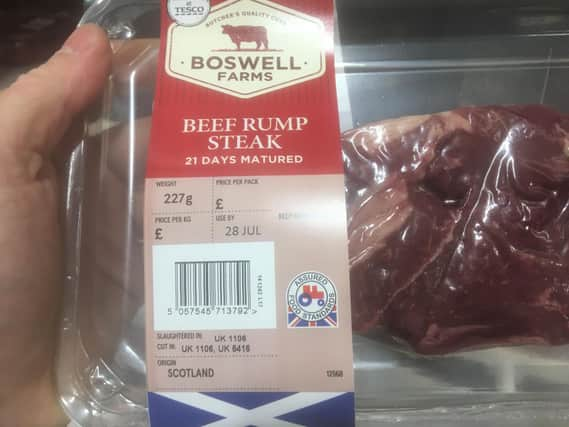Beef labelling in supermarkets adds to confusion


Terming the whole labelling scene ‘farcical’, the Scottish Beef Association (SBA) yesterday called on the Scottish Government and Food Standards Scotland (FSS) to take immediate steps to address the problem and allow consumers to correctly identify beef produced in Scotland.
The association also said that the degree of confusion was currently playing a key role in allowing beef products, especially from Ireland, to penetrate the Scottish market “through the back door.”
Advertisement
Hide AdAdvertisement
Hide Ad“During the Covid pandemic customers have backed local produce, but for that to continue they have to know what they are buying,” said the association’s chair, Aberdeenshire farmer, David Barron.
Speaking following a recent meeting with the Scottish Government and FSS Barron said that the ‘smoke and mirrors’ which retailers could adopt when labelling beef should be addressed urgently to stop such exploitation.
“It is no wonder the customer is confused when you look at the current jumble of labelling. Saltires, Country of Origin, Scottish, British and Red Tractor are plastered all over the packaging on the supermarket shelves but there is little clarity about what these terms really mean.”
Barron said that it was common to see high value cuts, such as steaks and briskets, co-mingled in such a way that even wary shoppers often struggled to identify whether beef was from Scotland or Ireland, adding that these labels were only used on premium cuts.
“The position is more confused on products such as mince where co-mingling is even more common. Processed products and ready meals should all be clearly labelled to show the source of their ingredients.”
Citing as an example of what he claimed was the confusion caused by labelling he pointed to the packaging used on rump steaks sold in Tesco.
“The code UK 1106 shows that the primary processing was carried out at Kepak’s plant at Portlethen. The retail packing was, however, carried out at UK 5146, which is the code for a third-party site 460 miles away in Huntingdon.”
It was believed this site also packed meat from England, the Republic of Ireland and Northern Ireland, with packs variously showing Red Tractor and Scotch Beef PGI and other labelling.
Advertisement
Hide AdAdvertisement
Hide AdPointing out that Scotch Beef PGI came from cattle which were born, reared and killed in Scotland, he said that Red Tractor was far less stringent, allowing older cattle to be included and requiring only a 90-day finishing period on an assured unit.
“And then we have the use of fictitious name such as Tesco’s Boswell Farms label which gives consumers a sense of confidence which we do not think is justified,” he concluded.
At the other end of the production cycle, yesterday’s Stirling bull sales saw a cracking trade with the Charolais average price rising by £1328 to £8449, and the sale reaching a top price of 24,000 gns.
Comments
Want to join the conversation? Please or to comment on this article.